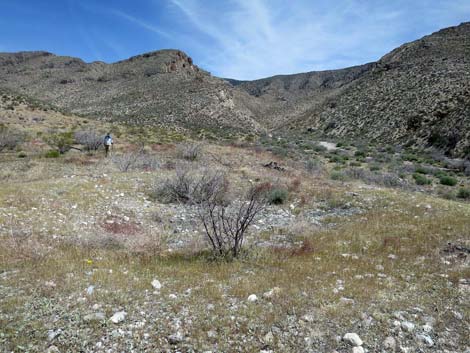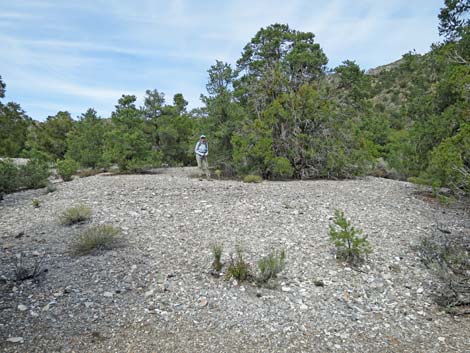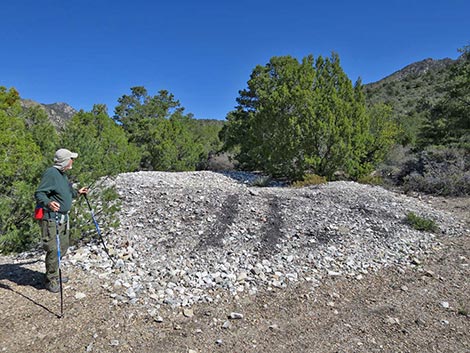
 Agave Roasting Pit along a dirt road |
Agave Roasting Pit An Agave Roasting Pit is a traditional earth-oven method for cooking hard, starchy foods, such as Utah Agave hearts (hence the name) and meats. Ancient Native Americans used agave roasting pits to cook agave hearts, yucca stalks, and the bananas from Banana Yuccas. They also used them to cook meats such as desert tortoises, chuckwallas, and desert bighorn sheep. In modern times, agave roasting pits are used to cook food for cultural preservation and for the production of artisanal mescal. Hawaiian luaus are a traditional celebration featuring a pig cooked in an earth oven, which is the same technology as agave roasting pits. |
 Fire-cracked limestone rocks mixed with gray ash |
Cooking with an agave roasting pit involves digging a pit in the ground, lining it with rocks, and filling the pit with wood. The wood is burned, and the fire heats the rocks. When the fire burns down to coals, the pit is filled with desired food items. The food is covered with vegetation (providing moisture for steam), covered with dirt and rocks for insulation, and left for a prolonged period, often days. In southern Nevada, the rocks used to line agave roasting pits are limestone because for the most part, these are the only rocks available. In some places, sandstone occurs, but sandstone does not hold heat the way limestone does. However, when limestone is cooked to temperatures in excess of about 900 degrees centigrade, the limestone changes to lime and no longer holds heat. |
 Signs remaining visitors to treat the land carefully |
Because cooked limestone no longer retains heat, it must be replaced, probably after every use. As the cooked lime is tossed out of the pit over time, it builds up in a ring around the cooking pit. A central depression with a raised ring of burnt limestone becomes what we see today in the mountains and deserts around Las Vegas. The full extent of an agave roasting pit can reach about 50-ft in diameter with a 15-ft diameter central cooking pit. Limestone (calcium carbonate) cooks to form calcium oxide (quick lime; caustic and alkaline). When mixed with water, it reacts to form slaked lime (calcium hydroxide). Calcium hydroxide is used in plasters, mortars, and many industrial and agricultural processes. |
 A field of enormous agave roasting pits, Gold Butte |
 Gigantic agave roasting pit, Gold Butte |
 Agave Roasting Pit damaged by ATVs, Gold Butte |
Happy hiking! All distances, elevations, and other facts are approximate.
![]() ; Last updated 250714
; Last updated 250714
| Main Glossary | Hiking Around Las Vegas | Copyright, Conditions, Disclaimer | Home |